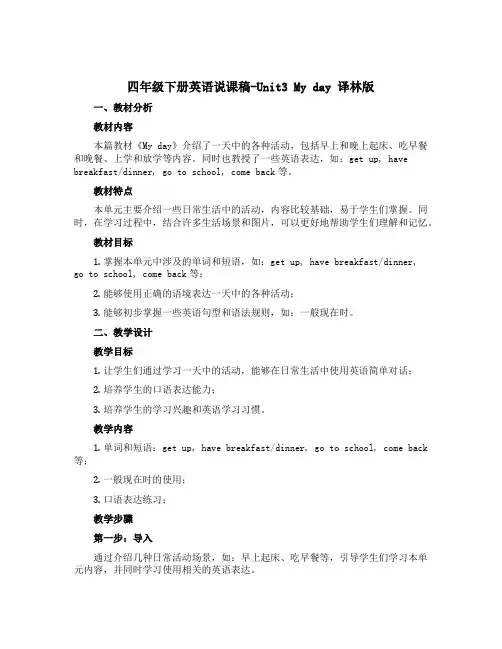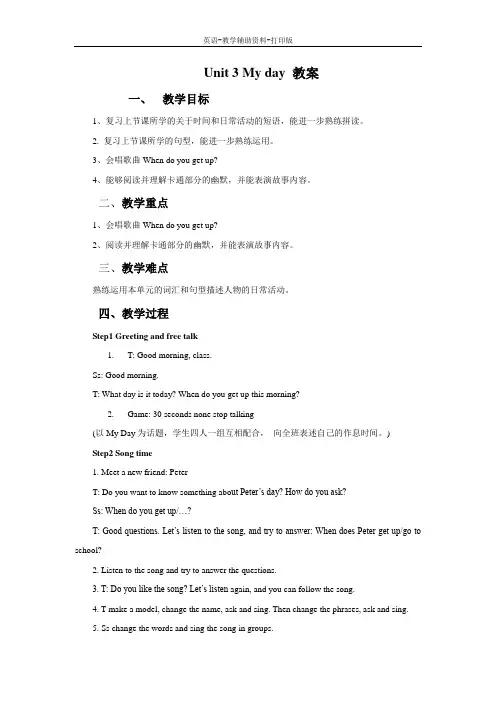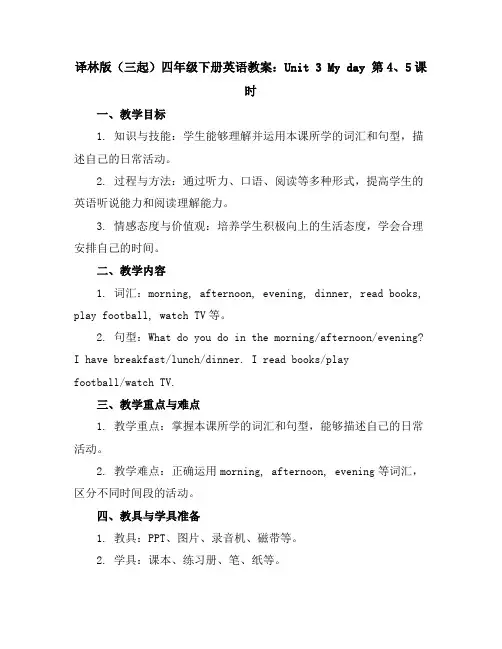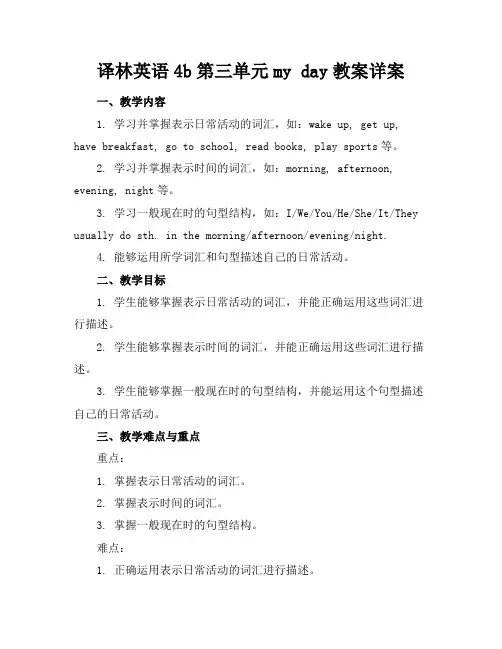译林版小学英语Unit 3 My day教案(4课时)
四年级下册英语说课稿-Unit3 My day 译林版

四年级下册英语说课稿-Unit3 My day 译林版一、教材分析教材内容本篇教材《My day》介绍了一天中的各种活动,包括早上和晚上起床、吃早餐和晚餐、上学和放学等内容。
同时也教授了一些英语表达,如:get up, have breakfast/dinner, go to school, come back等。
教材特点本单元主要介绍一些日常生活中的活动,内容比较基础,易于学生们掌握。
同时,在学习过程中,结合许多生活场景和图片,可以更好地帮助学生们理解和记忆。
教材目标1.掌握本单元中涉及的单词和短语,如:get up, have breakfast/dinner,go to school, come back等;2.能够使用正确的语境表达一天中的各种活动;3.能够初步掌握一些英语句型和语法规则,如:一般现在时。
二、教学设计教学目标1.让学生们通过学习一天中的活动,能够在日常生活中使用英语简单对话;2.培养学生的口语表达能力;3.培养学生的学习兴趣和英语学习习惯。
教学内容1.单词和短语:get up, have breakfast/dinner, go to school, come back 等;2.一般现在时的使用;3.口语表达练习;教学步骤第一步:导入通过介绍几种日常活动场景,如:早上起床、吃早餐等,引导学生们学习本单元内容,并同时学习使用相关的英语表达。
第二步:学习单词和短语通过对单词和短语的介绍,让学生们了解相关词汇的含义,并进行一些口语表达练习。
第三步:学习语法介绍一般现在时的概念和使用方法,并进行相应的例句练习。
同时,让学生们了解和掌握一些常用谓语动词的用法。
第四步:学习用法在学习语法的基础上,引导学生们学习句型的使用方法,并进行相应的口语表达练习。
第五步:巩固与拓展让学生们运用所学的知识,进行日常生活中相关的英语口语表达练习。
同时,为了更好地拓展知识面,也可以介绍一些相关文化和背景知识。
牛津译林版-英语-四下-Unit 3 My Day同步教案

Unit 3 My day 教案一、教学目标1、复习上节课所学的关于时间和日常活动的短语,能进一步熟练拼读。
2. 复习上节课所学的句型,能进一步熟练运用。
3、会唱歌曲When do you get up?4、能够阅读并理解卡通部分的幽默,并能表演故事内容。
二、教学重点1、会唱歌曲When do you get up?2、阅读并理解卡通部分的幽默,并能表演故事内容。
三、教学难点熟练运用本单元的词汇和句型描述人物的日常活动。
四、教学过程Step1 Greeting and free talk1.T: Good morning, class.Ss: Good morning.T: What day is it today? When do you get up this morning?2.Game: 30 seconds none stop talking(以My Day为话题,学生四人一组互相配合,向全班表述自己的作息时间。
)Step2 Song time1. Meet a new friend: PeterT: Do you want to know something abo ut Peter’s day? How do you ask?Ss: When do you get up/…?T: Good questions. Let’s listen to the song, and try to answer: When does Peter get up/go to school?2. Listen to the song and try to answer the questions.3. T: Do you like the song? Let’s listen again, and you can follow the song.4. T make a model, change the name, ask and sing. Then change the phrases, ask and sing.5. Ss change the words and sing the song in groups.Step3 Cartoon timeT: From the song, what do you think about Peter?Ss: He’s a good boy.T: Yes. He gets up at six thirty every day. And he goes to school at seven thirty every. He has good habits. I think you have good habits too, right? And so is Bobby.1.(Show a picture of Bobby on page15.) Bobby gets up at six every day. Do youknow when does Bobby have dinner every day? Guess.Ss: At five/six…?2.T: Yes, he has dinner at six every day. Does he have dinner at six today? Whathappened?Where is Bobby?A.In the desert (在沙漠里)B.At homeLet’s watch the cartoon and choose the correct one.Ss: B.3.T: What can they see over there? And does Bobby eat it at last? Read the story andanswer.Ss: They see a big cake over there.T: There’s a nice cake in the desert. But Bobby can not eat it.Because it’s a dream! Bobby is sleeping and he is very hungry. So he makes a dream.4.Good! Well, boys and girls, let’s learn the story together.Ss: Listen and repeat.T: 指导朗读。
译林版(三起)四年级下册英语教案:Unit3Myday第4、5课时

译林版(三起)四年级下册英语教案:Unit 3 My day 第4、5课时一、教学目标1. 知识与技能:学生能够理解并运用本课所学的词汇和句型,描述自己的日常活动。
2. 过程与方法:通过听力、口语、阅读等多种形式,提高学生的英语听说能力和阅读理解能力。
3. 情感态度与价值观:培养学生积极向上的生活态度,学会合理安排自己的时间。
二、教学内容1. 词汇:morning, afternoon, evening, dinner, read books, play football, watch TV等。
2. 句型:What do you do in the morning/afternoon/evening?I have breakfast/lunch/dinner. I read books/playfootball/watch TV.三、教学重点与难点1. 教学重点:掌握本课所学的词汇和句型,能够描述自己的日常活动。
2. 教学难点:正确运用morning, afternoon, evening等词汇,区分不同时间段的活动。
四、教具与学具准备1. 教具:PPT、图片、录音机、磁带等。
2. 学具:课本、练习册、笔、纸等。
五、教学过程1. 导入:通过唱英文歌曲《Good morning to you》来调动学生的积极性,引入新课。
2. 新课呈现:利用PPT展示本课的词汇和句型,让学生跟读并模仿。
3. 操练:通过小组合作、角色扮演等形式,让学生运用本课所学的词汇和句型进行口语练习。
4. 巩固:进行听力练习,让学生听录音并回答问题,检验学生对本课内容的掌握程度。
5. 应用:布置作业,让学生运用本课所学的词汇和句型,描述自己的日常活动。
六、板书设计1. Unit 3 My day2. 词汇:morning, afternoon, evening, dinner, read books, play football, watch TV等。
译林英语4b第三单元myday教案详案

译林英语4b第三单元my day教案详案一、教学内容1. 学习并掌握表示日常活动的词汇,如:wake up, get up, have breakfast, go to school, read books, play sports等。
2. 学习并掌握表示时间的词汇,如:morning, afternoon, evening, night等。
3. 学习一般现在时的句型结构,如:I/We/You/He/She/It/They usually do sth. in the morning/afternoon/evening/night.4. 能够运用所学词汇和句型描述自己的日常活动。
二、教学目标1. 学生能够掌握表示日常活动的词汇,并能正确运用这些词汇进行描述。
2. 学生能够掌握表示时间的词汇,并能正确运用这些词汇进行描述。
3. 学生能够掌握一般现在时的句型结构,并能运用这个句型描述自己的日常活动。
三、教学难点与重点重点:1. 掌握表示日常活动的词汇。
2. 掌握表示时间的词汇。
3. 掌握一般现在时的句型结构。
难点:1. 正确运用表示日常活动的词汇进行描述。
2. 正确运用表示时间的词汇进行描述。
3. 熟练运用一般现在时的句型结构描述自己的日常活动。
四、教具与学具准备1. 教具:多媒体课件、黑板、粉笔。
2. 学具:教材、练习本、文具。
五、教学过程1. 热身(5分钟)教师与学生进行简单的英语对话,如:Hello, class. How are you today?Good morning, teacher. We're fine, thank you.2. 引入(10分钟)教师向学生介绍自己的日常活动,如:In the morning, I usually wake up at 7 o'clock and have breakfast.In the afternoon, I often read books and have a rest.然后引导学生思考并讨论自己的日常活动。
2024年译林英语4BUnit3MyDay教案及课件分享

2024年译林英语 4B Unit3 My Day 教案及课件分享一、教学内容二、教学目标1. 能够听懂、会说、会读、会写本课所学的单词和句型,如:get up, go to school, have lunch, play football等。
2. 能够运用一般现在时态描述自己的日常活动,并能用所学句型进行简单对话。
3. 能够了解并尊重中西方文化差异,培养跨文化交际意识。
三、教学难点与重点1. 教学难点:一般现在时态的运用,描述日常活动的词汇和句型。
2. 教学重点:听、说、读、写能力的培养,以及跨文化交际意识的提高。
四、教具与学具准备1. 教具:PPT课件、录音机、磁带、卡片。
2. 学具:教材、练习本、彩色笔。
五、教学过程1. 导入:通过展示一组关于日常活动的图片,引导学生用英语说出图片内容,激发学生兴趣,为新课学习做好铺垫。
3. 活动一:小组合作,用一般现在时态描述组员的日常活动,并进行汇报。
4. 活动二:例题讲解,引导学生运用所学句型和词汇进行练习。
e.g. What do you do every day? I get up at 7:00, go to school at 7:30, and have lunch at 12:00.e.g. I _______ (have) breakfast at 7:30.六、板书设计1. My Day2. 内容:Time: 7:00, 7:30, 12:00,Activities: get up, go to school, have lunch, play football,Sentence patterns: What do you do every day? I七、作业设计1. 作业题目:(1)Write about your day using the words and sentence patterns we learned today.(2)Translate the following dialogue into English.A: What time do you get up?B: I get up at 6:30.A: What do you do after school?B: I play football with my friends.2. 答案:(1)My day: I get up at 7:00, go to school at 7:30, have lunch at 12:00, play football at 4:00, and go to bed at 9:00.(2)A: What time do you get up?B: I get up at 6:30.A: What do you do after school?B: I play football with my friends.八、课后反思及拓展延伸1. 课后反思:本节课通过图片、录音、例题等多种教学手段,让学生掌握了描述日常活动的基本词汇和句型,提高了学生的听、说、读、写能力。
译林版4Bunit3myday教案

译林版4Bunit3myday教案4B unit 3 story time 张媛媛一、teaching aims1.能听说读词汇:(19页)2. 1.能正确熟练朗读课文3.能与同学讨论自己的一天二.Teaching importance and difficulty同上三. Teaching processStep 1 warm up1.课前歌曲《Good morning to you》引出greetingT: Good morning to you, boys and girls.T: Nice to see youT: I am your teacher today, and maybe you know nothing about me. Let’s introduce myself first. (PPT第三张,配图片或视频,本周末准备好)T: It’s my turn to know you. So when do you get up?(PPT出示句型第四张,提示学生回答),提问3、4人。
T: Here are several different time and pictures, please try to match them and make a sentence, of course you can discuss in group. (PPT第五张,找生回答)Step 2 presentation出示并点击Mike 的图片,超链接课文动画。
T: Look, he’s our friend, mike, what about his day? Watch a cartoon at first, ok?T: Can you raise questions about him? (小组讨论之后,可PPT 提示)T: Great! You have raised so many good questions, but now you need to solve by yourself. Watch again please and completethe chart that I give you. (出示PPT第八页activity and time ) 学生说一组活动和时间就出示一组,全部结束T: These are your answers, let’s check together. 超链接点击课文录音。
江苏译林版四下《Unit 3 My day》教案
2.T: I watch TV at eight evening.(做看电视的动作) Now let’s play a game: Guess and say!(师做动作,学生快速说出表示的单词或短语)
Swim/play football/play basketball/skate/run/get up/go to school/eat/drink/go to bed…
Have dinner at six thirteen
Watch TV at seven in the evening
Go to bed at nine at night
4.Retell Mike’s day according to these pictures
Step3 Fun time
1.Show a timetable and finish it.
(Part1)
Ss listen and then choose the pictures.(出示五幅图:起床、看电视、上学、睡觉、吃午饭,学生听第一段,根据Mike的介绍选出早上的活动)
1.Listen again and match(再听一遍介绍,出现三个钟面,将Mike的活动与时间配对)
2.T: What else does Mike do in the morning?
1.It’s Monday today.
2.We have 4 lessons in the morning.
3.We have a PE lesson in the afternoon.
4.I like Music.
5.I go to school every day.
Unit3Myday(教案)译林版英语四年级下册(1)
Talk about the students’day.
在情境教学中,理解词汇和句型,达成目标3和4
文本理解中达成目标4.
通过这一环节,帮助学生复习本课的重点以及难点内容,更有效地达成整体目标。
开放式延伸
1.熟练朗读Story time,并能用自己的话说说Mike一天的活动;
5、通过Mike和教师一天的活动描述,尝试描述自己一天的学习生活,熟练运用句型I usually …at…及时间和活动的表达。
制定依据
1.教材分析
本课时的教学主要任务是story time,展示了本单元的短语和套用这些短语的句子,是本节课的学习重点。在教学时要复习数字,时间的表达方法,结合日常的活动复习已学的动词短语,拓展新的动词词组,进而形成句子,让学生学会用Iusually…at…描述自己的一天。
2、Read and finish the timetable;
(1)Please open your books, read the text and then underline the time, like this(做一个示范:at seven),then finish the timetable of Mike’s.
Unit 3 My day
教学目标
1、通过对游戏活动,复习数字及时间表达,从而能熟练地表达时间;
2、通过游戏活动,归纳所学活动类短语,从而熟练地表达一天的活动;
3、通过教师相关活动的呈现,学习新句型I usually…at…的表达,理解When do you …?
4、通过对文本的朗读、理解,了解Mike一天的活动,熟练朗读课文,进一步熟悉句型I…at…;
(2)11:15 Iusuallyhave lunchat11:15
译林英语四下教案Unit 3 My day 第四课时
译林英语四下教案Unit 3 My day 第四课时教学目标1.学习、复习并掌握课本 Unit 3 My day 第四课时中的单词和短语。
2.在听力模拟训练中增强学生们的听力水平。
3.学习并掌握如何描述自己的一天,并能够与同伴分享自己的一天活动。
教学准备1.课本 Unit 3 My day 第四课时,课件。
2.多媒体设备。
3.学生活动课件和相关练习。
教学重点和难点1.学习并掌握如何描述自己的一天。
2.学会用英语对自己的一天活动进行表述。
3.学生自主学习的能力。
教学步骤第一步:词汇学习1.教师出示联系学习单元中的单词和短语。
2.学生跟读并重复单词和短语。
第二步:听力活动1.教师出示一个学生的一天活动表。
2.教师朗读活动表中的内容,并让学生进行听力理解。
3.学生根据活动表内容,回答问题。
第三步:口语对话1.学生进行组队活动,每组两人。
2.学生与同伴交流自己一天中的活动,并使用学习单元的单词和短语。
3.教师对学生进行英语表达评价并指出不足之处。
第四步:活动练习1.学生完成相关的练习,并交换检查答案。
2.教师对答案进行检查,并强化学生们的错误纠正。
3.学生进行同步练习,自主探索和学习。
第五步:课程总结教师进行总结点评,强化学生们的听力,口语和写作技能,并提出下一个阶段课程目标。
课后作业1.回顾本课内容,查漏补缺。
2.尝试使用英语描述自己的一天活动。
3.完成学习相关题目。
教学评估根据课堂口语交流表现,同步练习结果和作业完成,对学生进行评估。
并根据评估结果,在后面的教学过程中进行调整。
译林英语4BUnit3MyDay优质教案及优质课件分享
译林英语 4B Unit3 My Day 优质教案及优质课件分享一、教学内容本节课我们将学习译林英语4B教材Unit3 "My Day"。
具体内容包括:课文A(Mike和Timmy一天),课文B(我学校生活),以及相关词汇和语法。
二、教学目标1. 让学生掌握描述日常活动词汇和表达方式。
2. 培养学生运用一般现在时描述自己和他人日常生活能力。
3. 增强学生听说读写综合运用能力。
三、教学难点与重点1. 教学难点:一般现在时运用,以及描述日常活动词汇。
2. 教学重点:让学生能够熟练运用所学知识描述自己和他人一天。
四、教具与学具准备1. 教具:PPT课件、磁带、录音机、卡片。
2. 学具:课本、练习本、彩笔。
五、教学过程1. 实践情景引入:邀请一位学生上台,展示并描述他日常生活。
2. 课文A学习:播放课文A录音,引导学生跟读,学习词汇和表达方式。
针对课文内容进行讲解,让学生理解并掌握一般现在时运用。
3. 例题讲解:以课文A为例,讲解如何描述一天活动。
4. 随堂练习:让学生分成小组,运用所学知识描述组员一天。
六、板书设计1. 课文A重点词汇和表达方式。
2. 一般现在时结构。
3. 课文B中词汇和表达方式。
七、作业设计1. 作业题目:描述你周末生活,至少包括5个日常活动。
2. 答案示例:On the weekend, I usually get up at 8:00. Then I have breakfast and watch TV. In the afternoon, I play football with my friends. After dinner, I read books and go to bed at 10:00.八、课后反思及拓展延伸1. 课后反思:本节课学生对于一般现在时掌握程度较好,但在词汇运用方面还需加强。
在今后教学中,要注重词汇拓展和练习。
2. 拓展延伸:鼓励学生在课后观察和记录家人或朋友日常生活,用所学知识进行描述,提高实际运用能力。
- 1、下载文档前请自行甄别文档内容的完整性,平台不提供额外的编辑、内容补充、找答案等附加服务。
- 2、"仅部分预览"的文档,不可在线预览部分如存在完整性等问题,可反馈申请退款(可完整预览的文档不适用该条件!)。
- 3、如文档侵犯您的权益,请联系客服反馈,我们会尽快为您处理(人工客服工作时间:9:00-18:30)。
译林版小学英语Unit 3 My day教案(4课时)课题Unit 3 My day Period 1 Story time教学目标1、在情境中学习词汇和动词短语go to school, usually, in the morning, have lunch, go home, do my homework, have dinner, watch TV, go to bed2、能在情境中整体感知故事内容3、能够较准确的朗读课文并在教师的指导下尝试表演。
4、能初步运用本课所学的词汇和句型I…at…描述人物的日常活动。
重点能在情境中正确理解故事内容,并能准确朗读故事难点1、读准单词usually。
2、能够较准确的朗读课文并在教师的指导下表演。
教学准备PPT教学过程教学过程设计教学调整及过程解读Step1 Greeting and warm upT: Good morning, class.Ss: Good morning.T: Do you like games? Let’s play a game: Yeah, yeah,yeah, or No, no ,no.1.It’s Monday today.2.We have 4 lessons in the morning.3.We have a PE lesson in the afternoon.4.I like Music.5.I go to school every day.6.It’s six o’clock. It’s time for English class.Step2 Presentation1.Show six clocks, review the time6:15 7:05 11:45 5:00 6:20 10:00T: What time is it? It’s six fifteen in the morning….(复习时间,并将钟面贴在黑板)Guess: What do I usually do at 6:15 in the morning?Ss: get up/have breakfast…T: I usually get up at 6:15板书:I(usually)…at…Teach: usuallyWhen do you get up?Ss: I get up at…2.In the same way to teach:go to school at 7:05have lunch at 11:45教学过程go home at 5:00have dinner at 6:20go to bed at 10:003. T: I do different things at different time.(Chant)I get up at six fifteen.I go to school at seven o five.I have lunch at eleven fifteen .I go home at five.I have dinner at six twentyI go to bed at ten.So this is my day.揭题:Unit 3 My day4. Talk in groups. Make a new chant, say something about your day.Step3 Story timeT: We’re having an English lesson and we’re talking about our days. Mike is talking about his day too. Let’s listen to Mike, try to find out Mike’s activities in the morning.(Part1)Ss listen and then choose the pictures.(出示五幅图:起床、看电视、上学、睡觉、吃午饭,学生听第一段,根据Mike的介绍选出早上的活动)1.Listen again and match(再听一遍介绍,出现三个钟面,将Mike的活动与时间配对)2.T: What else does Mike do in the morning?Ss: have lessonsT: Yes. And how many lessons does he have in the morning.Ss: Four.T: So Mike has four lessons in the morning.3.Listen and read Part 1.(Part2)1.T: How many lessons does Mike have in the afternoon? And what else does Mike do in the afternoon? Let’s listen again, and try to answer.Q1. How many lessons does Mike have in the afternoon?Q2. What else does Mike do in the afternoon? Teach: go homedo my homeworkIn the afternoon: have lessons/play football/go2.Listen and read Part 2(Part3)1.Read Part3 by selves, try to fill in the blanks.Activity TimeHave dinner7:002. Talk in groups: When does Mike do these things? Say like this:…at…3.Listen and read Part3Step 4Consolidation1.Read in three.2.Act as Mike, choose one part and talk about your activity.(三人一小组,扮演Mike,选择早、中、晚其中一个时间说说自己的活动)作业设计1.Listen and read the story, try to recite it.2. Describe your day to your family, then write it down.板书设计Unit 3 My dayI (usually) …at…In the morning/ afternoon / evening/ at nightget up go to school have lunch go home have dinner go to bed课后反思课题Unit 3 My day Period 2 Vocabulary & Fun time 教学目标1、能听懂会说:When do you ...?I...at…并能在情境中熟练的运用。
2、能熟练说出有关日常活动和时间的短语have lunch, play football, have dinner, go to bed, at night等。
6:15 7:05 11:45 5:00 6:20 10:003、能熟练运用本课所学的词汇和句型描述人物的日常活动。
4、学会统筹的安排时间,合理的安排自己的日程表,养成良好的生活和学习习惯。
重点掌握句型:When do you...? I usually ...at ... 并能熟练运用本课所学的词汇和句型描述人物的日常活动。
难点运用句型When do you...? I usually ...at ... 描述人物的日常活动教学准备PPT,板书教学过程设计教学调整及过程解读Step1 Greeting and warm upT: Good morning, class.Ss: Good morning.1.Review the time:T: What time is it now?(师拨时钟,学生迅速说出时间,最后拨时间8:00)2.T: I watch TV at eight evening.(做看电视的动作)Now let’s play a game: Guess and say!(师做动作,学生快速说出表示的单词或短语)Swim/play football/play basketball/skate/run/getup/go to school/eat/drink/go to bed…Step 2 Presentation1.(Show Mike.)Yesterday we learnt about Mike’s daily life. Nowlet’s look back again.2.(出示钟面)What time is it?Ss: It’s seven o’clock.T: Yes, it’s seven o’clock in the morning. What doesMike do at seven o’clock?(出示图片剪影)Guess!Ss: He gets up at seven.3. (出示另一个钟面)Teach:go to school in the same way.And what about this one?Ss: go to schoolTeach: get up/ go to school3.T: What does Mike usually do in the afternoon?Show two pictures.Ss: He …Teach:play football at four/go home at four forty in theafternoon.4:Show three pictures(have dinner/watch TV/go to bed)How about in the evening or at night? Please talk in groups. Then teach these phrases according to their answers:Have dinner at six thirteenWatch TV at seven in the eveningGo to bed at nine at night4.Retell Mike’s day according to these picturesStep3 Fun time1.Show a timetable and finish it.T: Do you want to know something about my day? You can ask me like this:Teach: When do you…?Ss: When do you get up?T: I get up at six in the morning.Ss ask ,T answers and draw the clocks.2.T: Look ,this is my day.(Introduce the T’s day) How about yours?3.Ss draw and write.4.Ask and answer in pairs(同桌各自询问对方的timetable。
